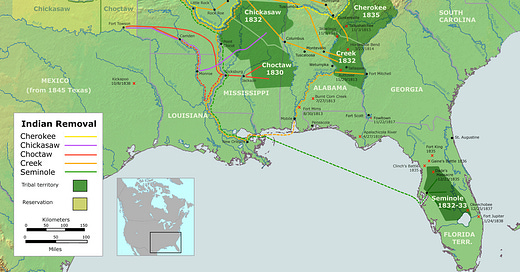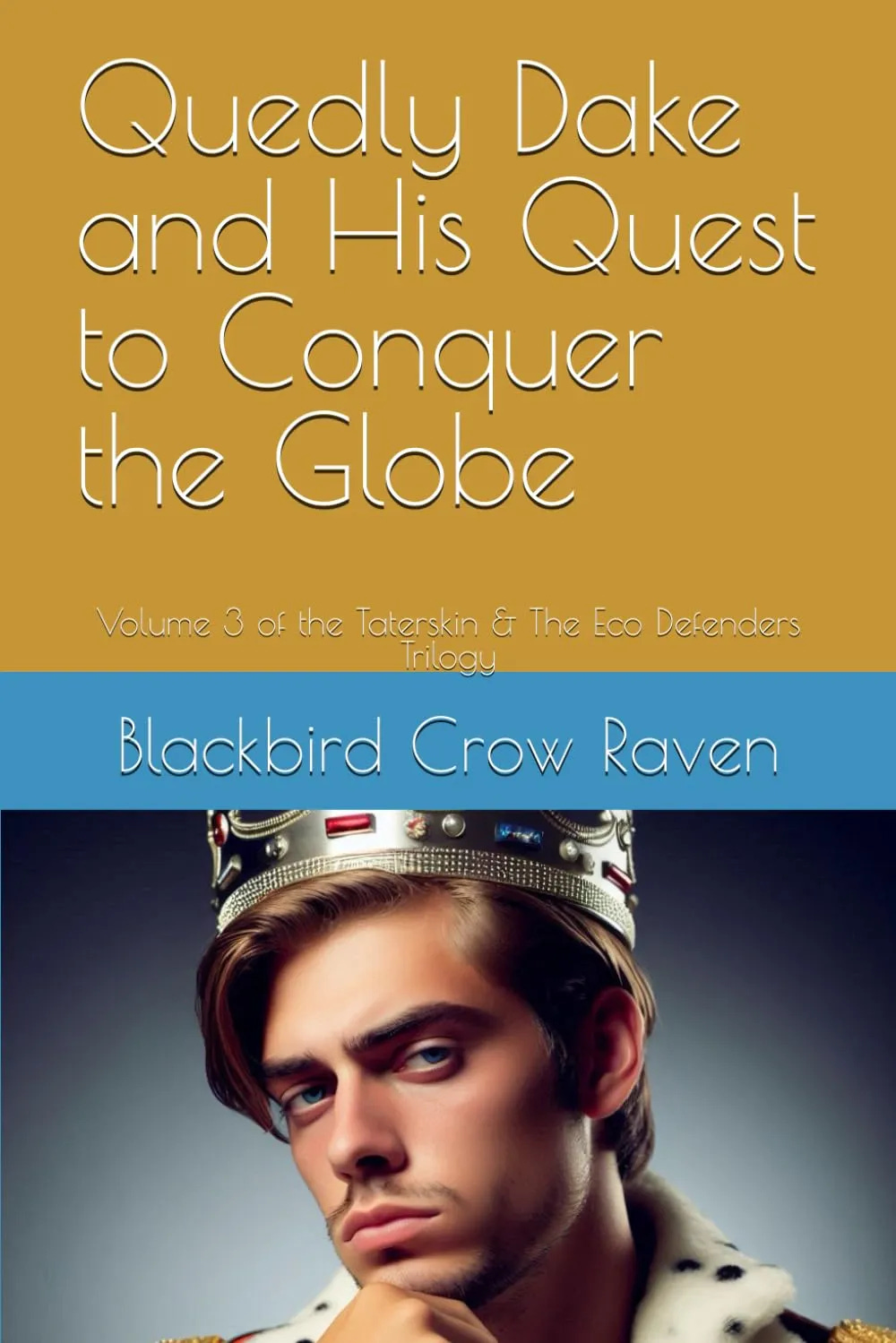The Mysteries of History (February 15 Edition)
Trail of Tears / Indian Removal Act; Spanish-American War
“Those who cannot remember the past are condemned to repeat it.” — Spanish-American philosopher George Santayana, 1905
1837 — Indian Removal Act / Trail of Tears
public domain image from wikimedia commons
On this date in 1837, the American Congress maneuvered to force Native Americans off their ancestral lands because the land they were living on was coveted by their supposedly Christian neighbors. 7th U.S. President Andrew Jackson (known as “Old Hickory” [back in the time when calling someone old was not a pejorative] to whites and “The Devil” to Indians) was a driving force behind the Indian Removal Act.
The following year, 1838, the U.S. Army forced Cherokees to abandon their land in Georgia and traipse approximately 1,000 miles to Indian Territory (which later had its named changed to Oklahoma when the white people decided they wanted that land, too, after all). This forced migration is known as The Trail of Tears, an arduous travail that became a death march as 4,000 of the tribe perished along the way from lack of food (starvation), exposure (freezing to death), and disease.
The following is an excerpt from my 2006 book Still Casting Shadows: A Shared Mosaic of U.S. History, Volume 1: 1620-1913
“If a man does not keep pace with his companions, perhaps it is because he hears a different drummer.”—from “Walden” by Henry David Thoreau
“If I have been correctly informed, the whites may do bad all their lives and then if they are sorry for it when about to die, all is well! But with us it is different; we must continue throughout our lives to do what we conceive to be good.”—Black Hawk, Sauk
“Their Wise Ones said we might have their religion, but when we tried to understand it we found that there were too many kinds of religion among white men for us to understand, and that scarcely any two white men agreed which was the right one to learn. This bothered us a good deal until we saw that the white man did not take his religion any more seriously than he did his laws, and that he kept both of them just behind him, like Helpers, to use when they might do him good in his dealings with strangers. These were not our ways. We kept the laws we made and lived our religion.”—Plenty-Coups, Crow
“It appears that they are anxious to pass on their religion, but keep very little of it for themselves.”—Ohiyesa, Sioux
“When the righteous become many, the people rejoice; but when anyone wicked bears rule, the people sigh.”—Proverbs 29:2
The Trail of Tears had begun a couple of decades earlier, but perhaps the most famous sufferers on the trail were the Cherokees, who were moved out of their ancestral territories primarily this year [1838], pushed by General Winfield Scott (“hero” of the war with Mexico) and his soldiers.
The Cherokee, who were one of the so-called “five civilized tribes” (because their culture and social system was similar to whites, having a formal constitution, leading an agrarian lifestyle, and sending their children to school) had won a lawsuit against the state of Georgia, permitting them, according to the U.S. Supreme Court, to retain possession of their land. This court victory was based on recognition of the Hopewell Treaties the U.S. government had concluded with the Cherokees in 1785 and 1786. When the Supreme Court said one thing and President Andrew Jackson said the opposite, though, it was Jackson’s will that was done. The executive branch of government, in this case, was unwilling to back up the judicial branch.
Andrew “The Devil” Jackson claimed that these prior treaties could be ignored because they were made by the federal government in violation of States’ (such as Georgia’s) rights. Yet he called the Indians’ habits savage and their institutions rude. Drawing a conclusion that makes the Mad Hatter seem sober and sensible by comparison, Jackson referred to his policy toward the Indians as a benevolent one. As the saying goes, “With friends like that, who needs enemies?”
Georgia had three basic reason for wanting to rid itself of the Cherokees in its midst: 1) Sovereignty (they didn’t want an independent nation living within its borders); 2) they wanted the Cherokee’s land; and 3) they wanted the gold that was on Cherokee lands (inadvertently revealed to the whites when a Cherokee boy sold a piece of gold jewelry to a white trader).
The Indians were not totally friendless among the members of white society. In 1838, Ralph Waldo Emerson wrote an open letter to President Martin Van Buren, who had succeeded Jackson as President the year before. In it, Emerson implored: We only state the fact that a crime is projected that confounds our understandings by its magnitude, a crime that really deprives us as well as the Cherokees of a country, for how could we call the conspiracy that should crush these poor Indians our government, or the land that was cursed by their parting and dying imprecations our country, any more? You, sir, will bring down that renowned chair in which you sit into infamy if your seal is set to this instrument of perfidy; and the name of this nation, hitherto the sweet omen of religion and liberty, will stink to the world.
Emerson’s plea fell on deaf ears. Martin Van Buren’s response was to send seven thousand federal troops and unnumbered Georgia militia to escort the Cherokees away from their former land. Not all involved relished their duty.
In a letter to his grandchildren written more than half a century after the event, John G. Burnett, who had been a U.S. Army private during the “Trail of Tears,” summed up his feelings on the matter this way:
However, murder is murder whether committed by the villain skulking in the dark or by uniformed men stepping to the strains of martial music. Murder is murder and somebody must answer, somebody must explain the streams of blood that flowed in the Indian country in the summer of 1838. Somebody must explain the four-thousand silent graves that mark the trail of the Cherokees to their exile. I wish I could forget it all, but the picture of six-hundred and forty-five wagons lumbering over the frozen ground with their Cargo of suffering humanity still lingers in my memory.
Let the Historian of a future day tell the sad story with its sighs, its tears and dying groans. Let the great judge of all the earth weigh our actions and reward us according to our work.
The President of the United States had a completely different take on the matter. In December of this year, eight months after Emerson wrote the scathing indictment and impassioned plea partially quoted above, Van Buren, the first President born a U.S. citizen (in other words, the first President born to American parents), crowed in a speech to Congress:
It affords sincere pleasure to apprise the Congress of the entire removal of the Cherokee Nation of Indians to their new homes west of the Mississippi. The measures authorized by Congress at its last session have had the happiest effects.
Happy effects? Four thousand Cherokees had died on the way to their “new homes” in present-day Oklahoma, a land that was also, in the main, eventually taken from them.
On the left above, my paternal great-grandmother Gertie Bailey Shannon (born Kansas 1883) and her son, my paternal grandfather, Theodore Roosevelt Shannon (born rural northern California 1902); on the right above, my maternal grandfather Albert Benjamin Lee Kollenborn (born rural northern Missouri 1907)
Questions: After being forced to relocate yet again (out of Indian Territory/Oklahoma), where were many Native Americans settled? How many Cherokee, descendants of those who traversed the Trail of Tears, remain in Oklahoma? Have you heard of The Cherokee Ozarks? Where exactly are they located? In your opinion, are Native Americans being treated fairly today, almost two centuries after the shame of the Indian Removal Act?
1898 — Remembering The Maine (Spanish-American War)
public domain image from wikimedia commons
Three quarters of the 350-man crew aboard the USS Maine battleship died from an explosion of not-known-for-sure origin on this date in 1898 off the coast of Cuba. It was claimed that Spain was behind the disaster (the Americans had sent the battleship to that island to protect American interests when a revolt by the Cubans against Spain had broken out) and that it was a deliberately placed mine that had killed the more than 260 men. Although this accusation has never been proven, it led to the outbreak of the Spanish-American War, which lasted only from April 21 until December 10, 1898, and to the popularization of the rallying cry, “Remember the Maine!”
After American forces quickly overpowered Spain, the United States gained as recompense (to the victor goes the spoils) control over new territories, including The Philippines, Puerto Rico, and Guam.
Although the cause of the explosion has still not been decisively resolved, a team of investigators came to the conclusion in 1976 that the deadly blast came about as a result of a fire onboard the ship igniting its stock of ammunition. In other words, it was likely a tragic accident rather than an act of sabotage.
For much more on the Spanish-American War and events surrounding it, see Chapter 1898: Wars for Countries and Worlds (pages 500-505) in my book Still Casting Shadows, mentioned and shown above.
Questions: Did the Americans want to go to war against Spain? Were they just looking for an excuse to do so? Did the Spanish want to get into a war with America, and what attempts did they make to defuse the volatile situation? How would the world be different today if the United States had not gained control of The Philippines, Puerto Rico, and Guam? What connection and influence did newspapermen Joseph Pulitzer and William Randolph Hearst have with and over the brouhaha?










Sunday and Monday (Feb 16 and 17) editions will not be published until Feb 18, Monday evening (I’m away from my computer until then)